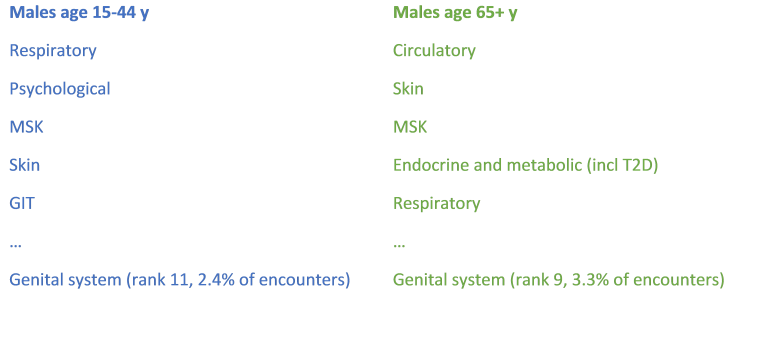Resources
FAQ: Teaching Your Registrar About Men's Health
Let’s start with a case study
Preventative interventions in males
Your female registrar discusses a 50 year-old man she saw this morning for a checkup:
- born in Vietnam
- emigrated in 1998
- speaks reasonable English
- a smoker
- obese
- high lipids
- BP 164/90
- HbA1c 6.6%
- has always thrown his National Bowel Screen kit in the bin.
She admits she became frustrated when much of the discussion side-tracked to whether he should get an STI check, because he said “I am married and don’t need those sorts of things”, becoming visually upset.
What are the possible learning points for your registrar?
- in terms of the consultation flow?
- in terms of communication?
- in terms of clinical value for preventive health effort?
In terms of health value, what are the greatest risks for this patient?
What does the RACGP Red Book Say?
For a man aged 50, the benefit is greatest for quitting smoking (24 fewer deaths per 1000 males per decade), which is 10 times the benefit of lowering lipids in a man with metabolic syndrome and 50 times greater than from participating in regular colorectal cancer screening.*
Benefits for women are generally lower, as their baseline risk is lower.*
*Ewald B, Del Mar C, Hoffman T. Quantifying the benefits and harms of various preventive health activities. AJGP (2018) vol 47:12
At what ago do you recommend PSA screening to your mal patients during a general checkup?
What does the RACGP Red Book Say?
- Screening is not recommended because the benefits have not been clearly shown to outweigh the harms
- GPs have no obligation to offer PSA testing to asymptomatic men
- If requested, after specific discussion to address the benefits and harms (from overdiagnosis and overtreatment) of prostate cancer screening, a PSA test is acceptable
- There is no doubt Australian doctors order too many PSA screening tests.**
** Coleman J. Excessive PSA testing in general practice. Med J Aust 2021; 215 (5)
BEACH statistics: male presentations in general practice


Frequently Asked Questions
WHAT ARE CONSIDERED THE MALE RISK FACTORS?
Overweight or obese; 1/4 older boys, 2/3 adult males
Sufficient physical activity in men ≥ 65y; 25%
Sufficient fruit and vegetable intake; 5%
4 out of 5 heroin overdose deaths occur in males
93% workplace deaths are in males (56% of the workforce)
Convicted for acts of violence, 90% male
Victims of violence, 80% male
Documented behavioural problems in schools, 90% male.
WHAT ARE THE PREDOMINANT CAUSES OF DEATH IN MALES?
In every age group (including infancy) male deaths > female
In 1900, average life expectancy males 55y, female 58y
<14y M:F Death from accidental injury 2:1
15–24y M:F MVA 3:1, suicide 3:1, all-cause 3.6:1
25–65y M:F CAD 4:1, accidents 4:1, suicide 3:1, cancer 2:1, all-cause 2:1
*** Murtagh’s General Practice, 8th edition (2022). Ch 102 Male Health
WHAT SHOULD WE ENCOURAGE REGISTRARS TO DO WHEN SEEING A MALE PATIENT?
Ask health screening questions and discuss preventative health measures
Raise sexual and mental health concerns
WHAT TIPS CAN WE PROVIDE REGISTRARS IN TERMS OF ENGAGEMENT WITH THEIR MALE PATIENTS?
Use their language – men have a wide variety in health literacy, sometimes unexpectedly
Assessing the patient’s literacy goes a long way in how you engage with each person and what type of health language you use
It is common that those with a lower health literacy have bigger health problems (lower socio-economic)
SHOULD THE REGISTRAR TRY TO FIND COMMON GROUND WITH THEIR MALE PATIENT?
Yes!
This can increase men’s engagement in their own health and therefore their relationship with their GP
Understanding the individual and what their interests are (i.e. footy team, occupation etc ) can enhance future engagement
Revealing your own interests (within reason – e.g. your footy team) can also enhance a patient-doctor relationship
HOW DO I DIRECT MY REGISTRAR'S COMMUNICATION WITH MALE PATIENTS?
When appropriate, simplify messages and instructions:
Information overload can be a major problem especially with complex medical issues
A simple approach can mean the difference between a patient engaging and disengaging
Clear-cut simplified written instructions can be helpful
WHAT ARE THE PRINCIPAL TASKS FOR GPS DEALING WITH MEN'S HEALTH PROBLEMS?
These can be summarised by the 5 A’s approach****
Ask about risk factors or early signs of major health problems.
Assess the level of risk and diagnose as early as possible.
Advise and motivate patients to lower their risk.
Assist patients with pharmacological and non-pharmacological therapies.
Arrange referral and follow-up.
Date reviewed: 15 February 2025
Please note that while reasonable care is taken to provide accurate information at the time of creation, we frequently update content and links as needed. If you identify any inconsistencies or broken links, please let us know by email.
